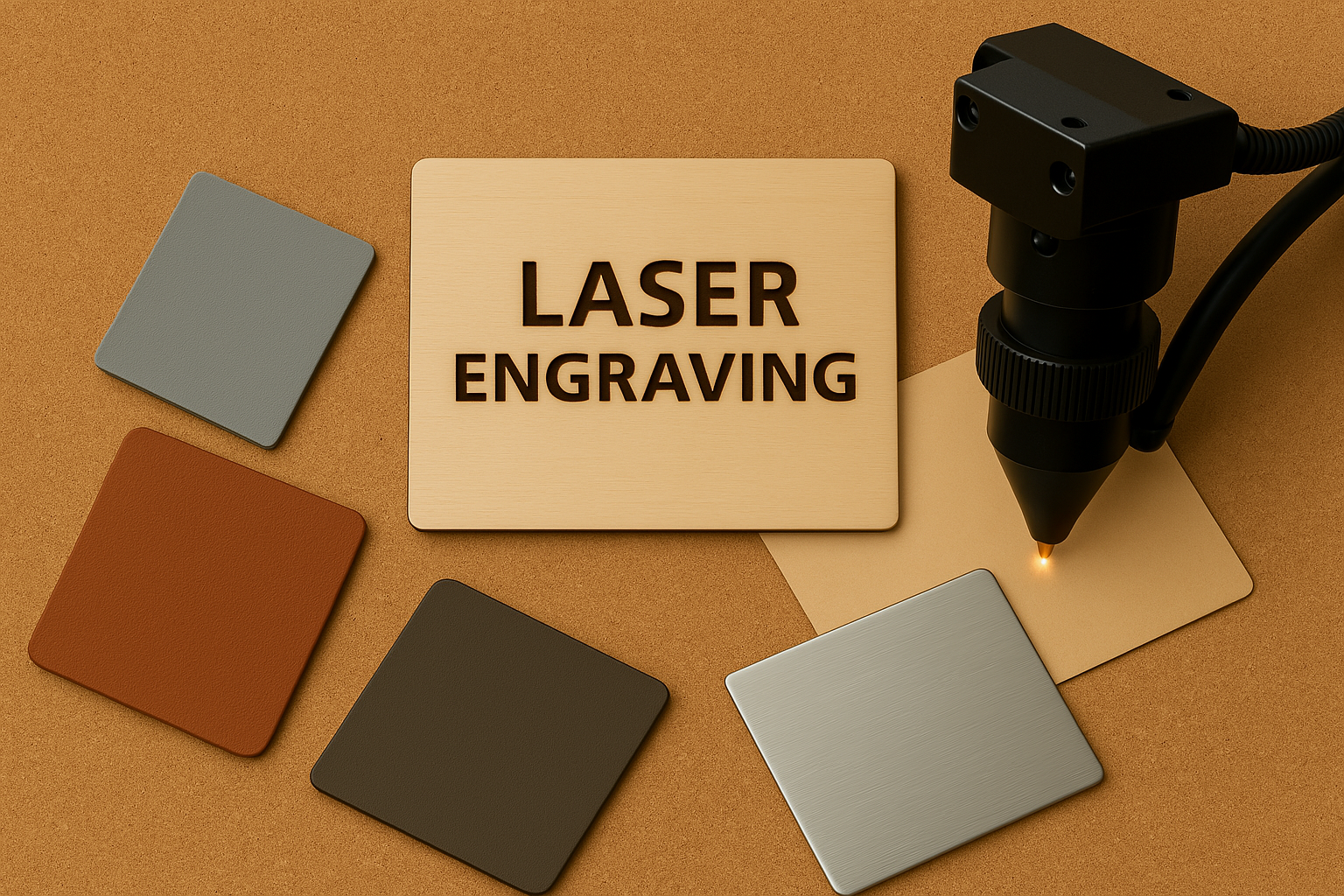Whether you’re a hobbyist, small business owner, or professional engraver, choosing the right material for laser engraving can make all the difference. The material determines not only how your final product looks, but also how clean, precise, and durable the engraving will be.
In this detailed guide, we’re exploring the top 5 laser engraving material types that offer outstanding results, based on visual impact, ease of use, and compatibility with common engraving machines like CO₂ lasers, fiber lasers, and CNC routers.
Let’s dive in!
1. Wood | The Classic Engraving Favorite
Wood is a timeless material in the world of laser engraving. It offers a natural texture, warm tones, and high contrast, especially when using hardwoods like:
- Walnut: Deep color with a rich grain
- Mahogany: Smooth surface, ideal for intricate patterns
- Maple: Light-toned wood that darkens beautifully when engraved
These woods handle laser energy well, producing clear and consistent results. While softwoods like pine can also be used, they may require additional adjustments due to uneven grain or sap content.
Best Uses:
- Custom wall signs and plaques
- Personalized wooden gifts (e.g., cutting boards, coasters)
- Rustic wedding decor
- Engraved boxes and keepsakes
Pro Tip: Use a lower engraving speed with a higher power setting for darker contrast on wood.
2. Acrylic | Modern, Versatile & Eye-Catching
Acrylic, especially cast acrylic, is a go-to material for anyone looking to produce bold, modern designs with precision. When engraved, it creates a frosted or white look, especially striking on clear or dark-colored acrylic sheets.
Unlike wood, acrylic is non-porous, meaning your designs will look ultra-sharp with little to no cleanup required.
Best Uses:
- Illuminated LED signs
- Business awards and trophies
- Decorative display panels
- Creative DIY projects
Engraving Tip: Always use cast acrylic instead of extruded, as it reacts better to laser engraving and produces a cleaner finish.
3. Anodized Aluminum | Durable & Professional
Anodized aluminum is a top pick for industrial, commercial, and branding applications. The anodized layer on the metal creates a hard surface that contrasts sharply when engraved, revealing the bright, raw aluminum beneath.
Not only is it visually striking, but it also ensures long-term durability and resistance to wear, weather, and corrosion.
Best Uses:
- Product ID tags and serial plates
- Custom business branding tools (e.g., pens, USB drives)
- Electronic device labels
- Outdoor signage
Good to Know: Fiber lasers work best on metals like anodized aluminum, but some CO₂ lasers with marking agents can also do the job.
4. Leather | Stylish, Textured & High-End
If you’re going for a sophisticated, tactile look, leather is your material. Laser engraving on leather produces a darkened, embossed effect, making your design pop with texture and richness.
Both genuine leather and PU (synthetic) leather can be used, but always test settings beforehand. However, some synthetics may contain chemicals that require ventilation.
Best Uses:
- Custom wallets, belts, and bags
- Engraved notebook or journal covers
- Branded fashion accessories
- Luxury packaging elements
Engraving Hack: Mask your leather with low-tack tape to prevent residue and achieve a cleaner burn.
5. Glass | Elegant & Timeless
Laser engraving on glass creates a beautifully frosted appearance, perfect for upscale gifting and decor. While engraving glass doesn’t vaporize the surface like other materials, the laser creates tiny fractures that result in a matte, etched look.
Tempered, clear, or frosted glass all work well, but remember, this process requires a gentle touch and a precise focus.
Best Uses:
- Personalized wine glasses and tumblers
- Decorative mirror engraving
- Commemorative plaques and awards
- Event keepsakes
Expert Tip: Use a wet paper towel over the glass during engraving to help reduce micro-fracturing and improve consistency.
Frequently Asked Questions
Q: Can any material be laser engraved?
A: No, always check the material’s composition. Some plastics and coated metals may release harmful fumes or not engrave cleanly.
Q: What’s the best laser engraving material for beginners?
A: Wood and acrylic are beginner-friendly because they offer forgiving surfaces, great contrast, and ease of use.
Q: How do I know which material works with my laser machine?
A: At Artbox Creative, our designs are compatible with:
- CO₂ lasers (e.g., Glowforge, OMTech, Epilog)
- Fiber lasers
- CNC machines
- Cricut (for simpler cuts)
Final Thoughts: Material Matters More Than You Think
The success of your laser engraving project depends not only on your machine or file but also on the material you choose. Each of these top 5 laser engraving materials like wood, acrylic, anodized aluminum, leather, and glass brings something unique to the table. No matter your project, whether you’re crafting custom gifts, professional signage, or branded merchandise, starting with the right material gives you a strong head start. To get your order placed you can also connect with us on Fiverr.

